Valorization of SCG through Extraction of Phenolic Compounds and Synthesis of New Biosorbent
Abstract
:1. Introduction
2. Spent Coffee Ground (SCG)
2.1. Production
2.2. Phenolic Compounds
2.3. Management
3. Extraction of Phenolic Compounds
3.1. Conventional Methods
3.2. Emerging Methods
3.2.1. Ultrasound-Assisted Extraction (UAE)
| Operating Conditions | Solvent | Yield | Antioxidant Activity | References |
|---|---|---|---|---|
| Ultrasound-assisted extraction | ||||
| P: 244 W, T: 40 °C, t: 34 min, L/S: 17 mL/g | Ethanol | ≤33.84 ± 0.59 mg GAE/g | - | [74] |
| T: 28 °C, t: 4.5 h | Ethanol, 60% v/v | 941.04 ± 37.25 mg GAE/g dry sample | 26.82 ± 2.92 mg Trolox Equivalents/g dry sample | [69] |
| After hydrothermal delignification of SCG, T: 40 °C, t: 40 min, L/S: 25 mL/g | Methanol, 100% v/v | 20.3 mg GAE/g | - | [75] |
| P: 750 W, frequency: 20 kWh, T: 50 °C, t: 60 min, L/S: 20 mL/g, | Ethanol, 60% v/v | 12.67 ± 0.31 mg GAE/g | EC50: 10.94 ± 0.55 μg/mL | [76] |
| Amplitude: 60%, T: 25 °C, t: 15 min, L/S: 9 mL/g | Methanol, 80% v/v | ≤9.51 ± 0.06 mg GAE/g | ≤0.89 ± 0.04 mmol FeSO4/100 g | [56] |
| Ultrasound pulse duration: 4 min, t: 60 min, L/S: 50 mL/g | Methanol/water, 1.25 | 19.29–24.95 mg GAE/g | 134.90–174.73 μmol Trolox/g | [16] |
| Amplitude: 60%, T: 60 °C, t: 20 min, L/S: 52 mL/g | Ethanol, 50% v/v | 18.54 mg GAE/g dry SCG | - | [64] |
| Microwave-assisted extraction | ||||
| P: 966 W, t: 49 s, L/S: 20 mL/g | Methanol, 60% v/v | ≤57.49 mg/g dry extract | 1488 μmoles Trolox Equivalents/g | [77] |
| P: 80 W, t: 40 s, L/S: 9 mL/g | Ethanol, 20% v/v | ≤398.95 mg GAE/g dry extract | DPPH: ≤90.69%, ≤3.02 mmol FeSO4/L | [17] |
| P: 550 W, t: 180 s, L/S: 12 mL/g | Ethanol, 20% v/v | 31.216 mg/g dry SCG | 36.56–98.24% DPPH: 2.62–6.66 mmol Fe2+/L | [78] |
| P: 600 W, t: 5 min, L/S: 60 mL/g | Ethanol, 68% v/v | 31.79 ± 0.25 mg GAE/g dry SCG | - | [64] |
| High-pressure-assisted extraction | ||||
| t: 60 min, L/S: 10 mL/g, T: 150 °C, P: 7 bar (0.7 MPa) | Ethanol, 50% v/v | 43 ± 0.8 mg caffeic acid equivalents/g dried biomass | 734 ± 11 μg trolox equivalents/g dried biomass | [79] |
| P: 300–500 MPa, T: 25 °C, t: 5–15 min, L/S: 9 mL/g | Methanol, 80% v/v | - | - | [56] |
3.2.2. Microwave-Assisted Extraction (MAE)
3.2.3. High-Pressure-Assisted Extraction (HPE)
4. Use as Biosorbents
| Pretreatment | Conditions | Adsorbed Compound | Yield | References |
|---|---|---|---|---|
| Drying at 105 °C for 5 h | stirring 100 rpm, pH 3–11, r: 5–30 g/L, C0: 50–500 mg/L, T: 25 °C, t: 15 min–12 h | Methylene blue from aqueous solution | 47–98% | [104] |
| - | pH 2–10, r: 25 g/L, C0: 0–200 mM, T: 25 °C, t: 2 h | Cadmium | ≤91.04% | [110] |
| Grinding, sieving, washing, and drying at 110 °C for 3 h | stirring 300 rpm, r: 10 g/L, C0: 10 mg/L, T: 25 °C, t: 3 h | Lead ions from aqueous solutions | ≤97% | [111] |
| Drying until decrease of moisture content by 50%, carbonization at 800, 1000, and 1200 °C | r: 3.33 g/L, C0: 100 mg/L, T: 25 °C, t: 10 days | Indigo carmine | 100% | [114] |
| Drying to constant weight, chemical activation with ZnCl2 and H3PO4 | r: 10 g/L, C0: 0.5 g/L, T: 30 °C, t: 5 days | Phenols and dyes from aqueous steams | - | [108] |
| Treatment with hot water, drying at 100 °C for 24 h, soaking in 1 M KOH for 24 h, drying at 105 °C for 12 h, carbonization at 500 °C | pH 7-9, C0: 20–40 ppm, T: 25 °C, t: 2–4 h | Aniline yellow dye | ≤88.72% | [115] |
| Treatment with potassium hydroxide, carbonization at 850 °C | stirring 350 rpm, C0: 10 mg/L | Μethylene blue | - | [63] |
| Magnetic modification | r: 3 g/L, t: 3 h | Water-soluble dyes and xenobiotics | 73.4 mg of dye/g dried adsorbent | [109] |
| Removal of phenolics, drying at 100 °C | t: 20 min, T: 30 °C, pH: 8, C0: 162.5 mg/L, S/L: 0.02 g/mL (OMW) t: 20 min, T: 40 °C, pH: 6, C0: 50 mg/L, S/L: 0.03 g/mL (gallic acid) | OMW phenolics, pure gallic acid aqueous solutions | 45.44% (OMW) 70.69% (gallic acid) | [106] |
| - | r: 0.1 and 1 g/L, C0: 100 mg/L, T: 24 °C, t: 24 h | Lead ions from drinking water | ≤95% | [112] |
| Air drying for 6 h | r: 10 g/L, t: 12 h | Cu, Zn, Cd, and Pb cations from aqueous solutions | ≤94.9% | [113] |
5. Future Challenges
6. Conclusions
Author Contributions
Funding
Institutional Review Board Statement
Informed Consent Statement
Data Availability Statement
Conflicts of Interest
Nomenclature
| Symbol | Description |
| A | Amplitude level |
| ARP1 | Antiradical power |
| C0 | Initial concentration of the adsorbed compound |
| CH | Coffee cherry husk |
| CP | Coffee pulp |
| CQA | Monocaffeoylquinic acids |
| diCQA | Dicaffeoylquinic acids. |
| DES | Deep eutectic solvents |
| DPPH | α, α-diphenyl-β-picrylhydrazyl (free radical scavenging method) |
| EC50/IC50 | Concentration of the sample necessary to decrease the initial DPPH concentration by 50% |
| EtOH | Aqueous ethanol |
| GAE | Gallic acid equivalent |
| HPE | High-pressure-assisted extraction |
| L/S | Solvent to solid ratio |
| MAE | Microwave-assisted extraction |
| r | Adsorbent dosage |
| SCG(s) | Spent coffee ground(s) |
| T | Temperature |
| t | Time |
| P | Microwave power |
| UAE | Ultrasound-assisted extraction |
References
- Kourmentza, C.; Economou, C.N.; Tsafrakidou, P.; Kornaros, M. Spent coffee grounds make much more than waste: Exploring recent advances and future exploitation strategies for the valorization of an emerging food waste stream. J. Clean. Prod. 2018, 172, 980–992. [Google Scholar] [CrossRef]
- International Coffee Organization. Available online: http://www.ico.org (accessed on 23 May 2022).
- Karmee, S.K. A spent coffee grounds based biorefinery for the production of biofuels, biopolymers, antioxidants and biocomposites. Waste Manag. 2018, 72, 240–254. [Google Scholar] [CrossRef]
- Getachew, A.T.; Chun, B.S. Influence of pretreatment and modifiers on subcritical water liquefaction of spent coffee grounds: A green waste valorization approach. J. Clean. Prod. 2017, 142, 3719–3727. [Google Scholar] [CrossRef]
- European Union Directive 2008/98/EC of the European Parliament and of the Council of 19 November 2008 on waste and repealing certain Directives. Off. J. Eur. Union 2008, 51, 3–30.
- European Union Council Directive 1999/31/EC on the landfill of waste. Off. J. L 1999, 182, 1–19.
- Campos-Vega, R.; Loarca-Piña, G.; Vergara-Castañeda, H.A.; Oomah, B.D. Spent coffee grounds: A review on current research and future prospects. Trends Food Sci. Technol. 2015, 45, 24–36. [Google Scholar] [CrossRef]
- Caetano, N.S.; Silva, V.F.M.; Melo, A.C.; Mata, T.M. Potential of spent coffee grounds for biodiesel production and other applications. Chem. Eng. Trans. 2013, 35, 1063–1068. [Google Scholar]
- Mussatto, S.I.; Carneiro, L.M.; Silva, J.P.A.; Roberto, I.C.; Teixeira, J.A. A study on chemical constituents and sugars extraction from spent coffee grounds. Carbohydr. Polym. 2011, 83, 368–374. [Google Scholar] [CrossRef] [Green Version]
- Kante, K.; Nieto-Delgado, C.; Rangel-Mendez, J.R.; Bandosz, T.J. Spent coffee-based activated carbon: Specific surface features and their importance for H2S separation process. J. Hazard. Mater. 2012, 201, 141–147. [Google Scholar] [CrossRef] [PubMed]
- Gomes, T.; Pereira, J.A.; Ramalhosa, E.; Casal, S.; Baptista, P. Effect of Fresh and Composted Spent Coffee Grounds on Lettuce Growth, Photosynthetic Pigments and Mineral Composition. In Proceedings of the VII Congreso Ibérico de Agroingeniería y Ciencias Horticolas, SECH e SEAgIng, Madrid, Spain, 26–29 August 2014; pp. 1–5. [Google Scholar]
- Ribeiro, J.P.; Vicente, E.D.; Gomes, A.P.; Nunes, M.I.; Alves, C.; Tarelho, L.A.C. Effect of industrial and domestic ash from biomass combustion, and spent coffee grounds, on soil fertility and plant growth: Experiments at field conditions. Environ. Sci. Pollut. Res. 2017, 24, 15270–15277. [Google Scholar] [CrossRef] [PubMed]
- Abrahão, F.R.; Rocha, L.C.R.; Santos, T.A.; do Carmo, E.L.; Pereira, L.A.S.; Borges, S.V.; Pereira, R.G.F.A.; Botrel, D.A. Microencapsulation of bioactive compounds from espresso spent coffee by spray drying. LWT 2019, 103, 116–124. [Google Scholar] [CrossRef]
- Kovalcik, A.; Obruca, S.; Marova, I. Valorization of Spent Coffee Grounds: A review. Food Bioprod. Process. 2018, 110, 104–119. [Google Scholar] [CrossRef]
- Ballesteros, L.F.; Ramirez, M.J.; Orrego, C.E.; Teixeira, J.A.; Mussatto, S.I. Optimization of autohydrolysis conditions to extract antioxidant phenolic compounds from spent coffee grounds. J. Food Eng. 2017, 199, 1–8. [Google Scholar] [CrossRef] [Green Version]
- Severini, C.; Derossi, A.; Fiore, A.G. Ultrasound-assisted extraction to improve the recovery of phenols and antioxidants from spent espresso coffee ground: A study by response surface methodology and desirability approach. Eur. Food Res. Technol. 2017, 243, 835–847. [Google Scholar] [CrossRef]
- Pavlović, M.D.; Buntić, A.V.; Šiler-Marinković, S.S.; Dimitrijević-Branković, S.I. Ethanol influenced fast microwave-assisted extraction for natural antioxidants obtaining from spent filter coffee. Sep. Purif. Technol. 2013, 118, 503–510. [Google Scholar] [CrossRef]
- Ruesgas-Ramón, M.; Figueroa-espinoza, M.C.; Durand, E. Application of Deep Eutectic Solvents (DES) for Phenolic Compounds Extraction: Overview, Challenges, and Opportunities. J. Agric. Food Chem. 2017, 65, 3591–3601. [Google Scholar] [CrossRef] [PubMed]
- Alonso, C.; Pérez, R.; Bazaga, P.; Medrano, M.; Herrera, C.M. MSAP markers and global cytosine methylation in plants: A literature survey and comparative analysis for a wild-growing species. Mol. Ecol. Resour. 2016, 16, 80–90. [Google Scholar] [CrossRef] [Green Version]
- Diamanti, A.C.; Igoumenidis, P.E.; Mourtzinos, I.; Yannakopoulou, K.; Karathanos, V.T. Green extraction of polyphenols from whole pomegranate fruit using cyclodextrins. Food Chem. 2017, 214, 61–66. [Google Scholar] [CrossRef]
- Goula, A.M.; Gerasopoulos, D. Integrated olive mill waste (OMW) processing toward complete by-product recovery of functional components. In Olives and Olive Oil as Functional Foods: Bioactivity, Chemistry and Processing; Wiley: New York, NY, USA, 2017; pp. 177–204. [Google Scholar]
- Ververi, M.; Goula, A.M. Pomegranate peel and orange juice by-product as new biosorbents of phenolic compounds from olive mill wastewaters. Chem. Eng. Process. Intensif. 2019, 138, 86–96. [Google Scholar] [CrossRef]
- Nasuha, N.; Hameed, B.H. Adsorption of methylene blue from aqueous solution onto NaOH-modified rejected tea. Chem. Eng. J. 2011, 166, 783–786. [Google Scholar] [CrossRef]
- Bertrand, B.; Guyot, B.; Anthony, F.; Lashermes, P. Impact of the Coffea canephora gene introgression on beverage quality of C. arabica. Theor. Appl. Genet. 2003, 107, 387–394. [Google Scholar] [CrossRef] [PubMed]
- Clarke, R.J.; Vitzthum, O.G. Coffee: Recent Developments; Blackwell Science Ltd.: Hoboken, NJ, USA, 2001. [Google Scholar]
- Zuorro, A.; Lavecchia, R. Spent coffee grounds as a valuable source of phenolic compounds and bioenergy. J. Clean. Prod. 2012, 34, 49–56. [Google Scholar] [CrossRef]
- Murthy, P.S.; Madhava Naidu, M. Sustainable management of coffee industry by-products and value addition—A review. Resour. Conserv. Recycl. 2012, 66, 45–58. [Google Scholar] [CrossRef]
- Mata, T.M.; Martins, A.A.; Caetano, N.S. Bio-refinery approach for spent coffee grounds valorization. Bioresour. Technol. 2018, 247, 1077–1084. [Google Scholar] [CrossRef] [PubMed]
- Vardon, D.R.; Moser, B.R.; Zheng, W.; Witkin, K.; Evangelista, R.L.; Strathmann, T.J.; Rajagopalan, K.; Sharma, B.K. Complete utilization of spent coffee grounds to produce biodiesel, bio-oil, and biochar. ACS Sustain. Chem. Eng. 2013, 1, 1286–1294. [Google Scholar] [CrossRef]
- Cruz, R.; Cardoso, M.M.; Fernandes, L.; Oliveira, M.; Mendes, E.; Baptista, P.; Morais, S.; Casal, S. Espresso Coffee Residues: A Valuable Source of Unextracted Compounds. J. Agric. Food Chem. 2012, 60, 7777–7784. [Google Scholar] [CrossRef]
- Acevedo, F.; Rubilar, M.; Scheuermann, E.; Cancino, B.; Uquiche, E.; Garcés, M.; Inostroza, K.; Shene, C. Spent coffee grounds as a renewable source of bioactive compounds. J. Biobased Mater. Bioenergy 2013, 7, 420–428. [Google Scholar] [CrossRef]
- Acevedo, F.; Rubilar, M.; Scheuermann, E.; Cancino, B.; Uquiche, E.; Garcés, M.; Inostroza, K.; Shene, C. Bioactive Compounds of Spent Coffee Grounds, a Coffee Industrial Residue. In Proceedings of the III Symposium on Advanced Magnetic Materials and Applications, Taiwan, China, 21–25 July 2013; Volume 212. [Google Scholar]
- Cerino-Córdova, F.J.; Dávila-Guzmán, N.E.; León, A.M.G.; Salazar-Rabago, J.J.; Soto-Regalado, E. Revalorization of coffee waste. In Coffee-Production and Research; IntechOpen: London, UK, 2020; p. 133. ISBN 183880885X. [Google Scholar]
- Ballesteros, L.F.; Teixeira, J.A.; Mussatto, S.I. Chemical, functional, and structural properties of spent coffee grounds and coffee silverskin. Food Bioprocess Technol. 2014, 7, 3493–3503. [Google Scholar] [CrossRef] [Green Version]
- Delgado, P.A.; Vignoli, J.A.; Siika-aho, M.; Franco, T.T. Sediments in coffee extracts: Composition and control by enzymatic hydrolysis. Food Chem. 2008, 110, 168–176. [Google Scholar] [CrossRef]
- Farah, A.; Donangelo, C.M. Phenolic compounds in coffee. Braz. J. Plant Physiol. 2006, 18, 23–36. [Google Scholar] [CrossRef]
- Yen, W.-J.; Wang, B.-S.; Chang, L.-W.; Duh, P.-D. Antioxidant properties of roasted coffee residues. J. Agric. Food Chem. 2005, 53, 2658–2663. [Google Scholar] [CrossRef] [PubMed]
- Rawel, H.M.; Kulling, S.E. Nutritional contribution of coffee, cacao and tea phenolics to human health. J. Verbrauch. Leb. 2007, 2, 399–406. [Google Scholar] [CrossRef]
- Brezová, V.; Šlebodová, A.; Staško, A. Coffee as a source of antioxidants: An EPR study. Food Chem. 2009, 114, 859–868. [Google Scholar] [CrossRef]
- Sul, D.; Kim, H.-S.; Lee, D.; Joo, S.S.; Hwang, K.W.; Park, S.-Y. Protective effect of caffeic acid against beta-amyloid-induced neurotoxicity by the inhibition of calcium influx and tau phosphorylation. Life Sci. 2009, 84, 257–262. [Google Scholar] [CrossRef] [PubMed]
- Jeong, C.-H.; Jeong, H.R.; Choi, G.N.; Kim, D.-O.; Lee, U.K.; Heo, H.J. Neuroprotective and anti-oxidant effects of caffeic acid isolated from Erigeron annuus leaf. Chin. Med. 2011, 6, 25. [Google Scholar] [CrossRef] [Green Version]
- Kim, S.Y. Neuroprotective and Neurotrophic Agents. In Research Focus on Natural Products and the Body’s Immune and Inflammatory Systems; Suk, K., Ed.; Nova Science Publishers: New York, NY, USA, 2007; pp. 23–39. [Google Scholar]
- Bravo, J.; Juaniz, I.; Monente, C.; Caemmerer, B.; Kroh, L.W.; De Peña, M.P.; Cid, C. Evaluation of spent coffee obtained from the most common coffeemakers as a source of hydrophilic bioactive compounds. J. Agric. Food Chem. 2012, 60, 12565–12573. [Google Scholar] [CrossRef]
- Ramalakshmi, K.; Rao, L.J.M.; Takano-Ishikawa, Y.; Goto, M. Bioactivities of low-grade green coffee and spent coffee in different in vitro model systems. Food Chem. 2009, 115, 79–85. [Google Scholar] [CrossRef]
- Monente, C.; Bravo, J.; Vitas, A.I.; Arbillaga, L.; De Peña, M.P.; Cid, C. Coffee and spent coffee extracts protect against cell mutagens and inhibit growth of food-borne pathogen microorganisms. J. Funct. Foods 2015, 12, 365–374. [Google Scholar] [CrossRef]
- Seo, H.S.; Park, B.H. Phenolic compound extraction from spent coffee grounds for antioxidant recovery. Korean J. Chem. Eng. 2019, 36, 186–190. [Google Scholar] [CrossRef]
- U.S. Environmental Protection Agency (EPA). Recycling Basics. 2017. Available online: https://www.epa.gov/recycle/recycling-basics (accessed on 5 August 2017).
- Rajesh Banu, J.; Kavitha, S.; Yukesh Kannah, R.; Dinesh Kumar, M.; Preethi; Atabani, A.E.; Kumar, G. Biorefinery of spent coffee grounds waste: Viable pathway towards circular bioeconomy. Bioresour. Technol. 2020, 302, 122821. [Google Scholar] [CrossRef]
- Simões, J.; Nunes, F.M.; Domingues, M.R.; Coimbra, M.A. Extractability and structure of spent coffee ground polysaccharides by roasting pre-treatments. Carbohydr. Polym. 2013, 97, 81–89. [Google Scholar] [CrossRef] [PubMed]
- Low, J.H.; Rahman, W.A.W.A.; Jamaluddin, J. Structural elucidation of tannins of spent coffee grounds by CP-MAS 13C NMR and MALDI-TOF MS. Ind. Crops Prod. 2015, 69, 456–461. [Google Scholar] [CrossRef] [Green Version]
- Choi, B.; Koh, E. Spent coffee as a rich source of antioxidative compounds. Food Sci. Biotechnol. 2017, 26, 921–927. [Google Scholar] [CrossRef] [PubMed]
- Kan, T.; Strezov, V.; Evans, T. Catalytic pyrolysis of coffee grounds using NiCu-impregnated catalysts. Energy Fuels 2014, 28, 228–235. [Google Scholar] [CrossRef]
- Jenkins, R.W.; Stageman, N.E.; Fortune, C.M.; Chuck, C.J. Effect of the type of bean, processing, and geographical location on the biodiesel produced from waste coffee grounds. Energy Fuels 2014, 28, 1166–1174. [Google Scholar] [CrossRef]
- Jooste, T.; García-Aparicio, M.P.; Brienzo, M.; Van Zyl, W.H.; Görgens, J.F. Enzymatic hydrolysis of spent coffee ground. Appl. Biochem. Biotechnol. 2013, 169, 2248–2262. [Google Scholar] [CrossRef]
- Sampaio, A.; Dragone, G.; Vilanova, M.; Oliveira, J.M.; Teixeira, J.A.; Mussatto, S.I. Production, chemical characterization, and sensory profile of a novel spirit elaborated from spent coffee ground. LWT-Food Sci. Technol. 2013, 54, 557–563. [Google Scholar] [CrossRef] [Green Version]
- Okur, I.; Soyler, B.; Sezer, P.; Oztop, M.H.; Alpas, H. Improving the Recovery of Phenolic Compounds from Spent Coffee Grounds (SCG) by Environmentally Friendly Extraction Techniques. Molecules 2021, 26, 613. [Google Scholar] [CrossRef]
- Zhang, Q.-W.; Lin, L.-G.; Ye, W.-C. Techniques for extraction and isolation of natural products: A comprehensive review. Chin. Med. 2018, 13, 20. [Google Scholar] [CrossRef] [PubMed] [Green Version]
- Alara, O.R.; Abdurahman, N.H.; Ukaegbu, C.I. Extraction of phenolic compounds: A review. Curr. Res. Food Sci. 2021, 4, 200–214. [Google Scholar] [CrossRef]
- Zuorro, A.; Lavecchia, R. Influence of extraction conditions on the recovery of phenolic antioxidants from Spent Coffee Grounds. Am. J. Appl. Sci. 2013, 10, 478–486. [Google Scholar] [CrossRef] [Green Version]
- da Silva Araújo, C.; Vimercati, W.C.; Macedo, L.L.; Pimenta, C.J. Effect of solvent, method, time and temperature of extraction on the recovery of phenolic compounds and antioxidants from spent coffee grounds. Int. J. Food Eng. 2022, 18, 325–336. [Google Scholar] [CrossRef]
- Mussatto, S.I.; Ballesteros, L.F.; Martins, S.; Teixeira, J.A. Extraction of antioxidant phenolic compounds from spent coffee grounds. Sep. Purif. Technol. 2011, 83, 173–179. [Google Scholar] [CrossRef] [Green Version]
- Panusa, A.; Zuorro, A.; Lavecchia, R.; Marrosu, G.; Petrucci, R. Recovery of Natural Antioxidants from Spent Coffee Grounds. J. Agric. Food Chem. 2013, 61, 4162–4168. [Google Scholar] [CrossRef] [PubMed]
- Ramón-Gonçalves, M.; Alcaraz, L.; Pérez-Ferreras, S.; León-González, M.E.; Rosales-Conrado, N.; López, F.A. Extraction of polyphenols and synthesis of new activated carbon from spent coffee grounds. Sci. Rep. 2019, 9, 17706. [Google Scholar] [CrossRef] [PubMed] [Green Version]
- Solomakou, N.; Loukri, A.; Tsafrakidou, P.; Michaelidou, A.-M.; Mourtzinos, I.; Goula, A.M. Recovery of phenolic compounds from spent coffee grounds through optimized extraction processes. Sustain. Chem. Pharm. 2022, 25, 100592. [Google Scholar] [CrossRef]
- Li, H.; Pordesimo, L.; Weiss, J. High intensity ultrasound-assisted extraction of oil from soybeans. Food Res. Int. 2004, 37, 731–738. [Google Scholar] [CrossRef]
- Vinatoru, M. An overview of the ultrasonically assisted extraction of bioactive principles from herbs. Ultrason. Sonochem. 2001, 8, 303–313. [Google Scholar] [CrossRef]
- Shirzad, H.; Niknam, V.; Taheri, M.; Ebrahimzadeh, H. Ultrasound-assisted extraction process of phenolic antioxidants from Olive leaves: A nutraceutical study using RSM and LC–ESI–DAD–MS. J. Food Sci. Technol. 2017, 54, 2361–2371. [Google Scholar] [CrossRef]
- Syahir, A.; Sulaiman, S.; Mel, M.; Othman, M.; Sulaiman, S.Z. An Overview: Analysis of Ultrasonic-Assisted Extraction’s Parameters and Its Process. In Proceedings of the IOP Conference Series: Materials Science and Engineering; IOP Publishing: Bristol, UK, 2020; Volume 778, p. 12165. [Google Scholar]
- Ansori, N.U.R.I.; Zainol, M.K.; Zin, Z.M. Antioxidant Activities of Different Varieties of Spent Coffee Ground (SCG) Extracted Using Ultrasonic-Ethanol Assisted Extraction Method. Univ. Malays. Teren. J. Undergrad. Res. 2021, 3, 33–42. [Google Scholar] [CrossRef]
- Teng, H.; Chen, L.; Huang, Q.; Wang, J.; Lin, Q.; Liu, M.; Lee, W.Y.; Song, H. Ultrasonic-assisted extraction of raspberry seed oil and evaluation of its physicochemical properties, fatty acid compositions and antioxidant activities. PLoS ONE 2016, 11, e0153457. [Google Scholar] [CrossRef] [PubMed]
- Yang, L.; Yin, P.; Fan, H.; Xue, Q.; Li, K.; Li, X.; Sun, L.; Liu, Y. Response surface methodology optimization of ultrasonic-assisted extraction of Acer truncatum leaves for maximal phenolic yield and antioxidant activity. Molecules 2017, 22, 232. [Google Scholar] [CrossRef] [PubMed] [Green Version]
- Buddin, M.; Rithuan, M.Z.A.; Surni, M.S.A.; Jamal, N.H.M.; Faiznur, M.F. Ultrasonic assisted extraction (UAE) of Moringa oleifera Seed Oil: Kinetic study. ASM Sci. J. 2018, 11, 158–166. [Google Scholar]
- Zhou, Y.; Zheng, J.; Gan, R.-Y.; Zhou, T.; Xu, D.-P.; Li, H.-B. Optimization of ultrasound-assisted extraction of antioxidants from the mung bean coat. Molecules 2017, 22, 638. [Google Scholar] [CrossRef] [PubMed] [Green Version]
- Al-Dhabi, N.A.; Ponmurugan, K.; Maran Jeganathan, P. Development and validation of ultrasound-assisted solid-liquid extraction of phenolic compounds from waste spent coffee grounds. Ultrason. Sonochem. 2017, 34, 206–213. [Google Scholar] [CrossRef]
- Arauzo, P.J.; Lucian, M.; Du, L.; Olszewski, M.P.; Fiori, L.; Kruse, A. Improving the recovery of phenolic compounds from spent coffee grounds by using hydrothermal delignification coupled with ultrasound assisted extraction. Biomass Bioenergy 2020, 139, 105616. [Google Scholar] [CrossRef]
- Caballero-Galván, A.S.; Restrepo-Serna, D.L.; Ortiz-Sánchez, M.; Cardona-Alzate, C.A. Analysis of extraction kinetics of bioactive compounds from spent coffee grounds (Coffea arábica). Waste Biomass Valorization 2018, 9, 2381–2389. [Google Scholar] [CrossRef]
- Budaraju, S.V.R.N.; Mallikarjunan, K.P.; Petit, R. Comparison and Optimization of Solvent Extraction and Microwave Assisted Extraction of Phenolic Compounds from Spent Coffee Grounds. In Proceedings of the 2017 ASABE Annual International Meeting, Washington, DC, USA, 16–19 July 2017; American Society of Agricultural and Biological Engineers: St. Joseph, MI, USA, 2017; p. 1. [Google Scholar]
- Ranic, M.; Nikolic, M.; Pavlovic, M.; Buntic, A.; Siler-Marinkovic, S.; Dimitrijevic-Brankovic, S. Optimization of microwave-assisted extraction of natural antioxidants from spent espresso coffee grounds by response surface methodology. J. Clean. Prod. 2014, 80, 69–79. [Google Scholar] [CrossRef]
- da Silva, M.F.; Pettinato, M.; Casazza, A.A.; Maciel, M.I.S.; Perego, P. Design and evaluation of non-conventional extraction for bioactive compounds recovery from spent coffee (Coffea arabica L.) grounds. Chem. Eng. Res. Des. 2022, 177, 418–430. [Google Scholar] [CrossRef]
- Upadhyay, R.; Ramalakshmi, K.; Rao, L.J.M. Microwave-assisted extraction of chlorogenic acids from green coffee beans. Food Chem. 2012, 130, 184–188. [Google Scholar] [CrossRef]
- Xie, Z.; Yang, J.; Huang, X.; Huang, Y. Microwave processing and properties of ceramics with different dielectric loss. J. Eur. Ceram. Soc. 1999, 19, 381–387. [Google Scholar] [CrossRef]
- Karunanithy, C.; Muthukumarappan, K.; Gibbons, W.R. Sequential extrusion-microwave pretreatment of switchgrass and big bluestem. Bioresour. Technol. 2014, 153, 393–398. [Google Scholar] [CrossRef] [PubMed]
- Sun, J.; Wang, W.; Yue, Q.; Ma, C.; Zhang, J.; Zhao, X.; Song, Z. Review on microwave–metal discharges and their applications in energy and industrial processes. Appl. Energy 2016, 175, 141–157. [Google Scholar] [CrossRef]
- Zhang, H.-F.; Yang, X.-H.; Wang, Y. Microwave assisted extraction of secondary metabolites from plants: Current status and future directions. Trends Food Sci. Technol. 2011, 22, 672–688. [Google Scholar] [CrossRef]
- Dudley, G.B.; Richert, R.; Stiegman, A.E. On the existence of and mechanism for microwave-specific reaction rate enhancement. Chem. Sci. 2015, 6, 2144–2152. [Google Scholar] [CrossRef]
- Kaufmann, B.; Christen, P.; Veuthey, J. Parameters affecting microwave-assisted extraction of withanolides. Phytochem. Anal. An Int. J. Plant Chem. Biochem. Tech. 2001, 12, 327–331. [Google Scholar] [CrossRef] [PubMed]
- Nour, A.H.; Oluwaseun, A.R.; Nour, A.H.; Omer, M.S.; Ahmad, N. Microwave-assisted extraction of bioactive compounds. In Theory and Practice; Springer: Berlin/Heidelberg, Germany, 2021; pp. 1–31. [Google Scholar]
- Shams, K.A.; Abdel-Azim, N.S.; Saleh, I.A.; Hegazy, M.F.; El-Missiry, M.M.; Hammouda, F.M.; Bohouth, E.; Tahrir, E. Green technology: Economically and environmentally innovative methods for extraction of medicinal & aromatic plants (MAP) in Egypt. J. Chem. Pharm. Res 2015, 7, 1050–1074. [Google Scholar]
- Huie, C.W. A review of modern sample-preparation techniques for the extraction and analysis of medicinal plants. Anal. Bioanal. Chem. 2002, 373, 23–30. [Google Scholar] [CrossRef]
- Mandal, V.; Mohan, Y.; Hemalatha, S. Microwave assisted extraction—An innovative and promising extraction tool for medicinal plant research. Pharmacogn. Rev. 2007, 1, 7–18. [Google Scholar]
- Gao, M.; Huang, W.; RoyChowdhury, M.; Liu, C. Microwave-assisted extraction of scutellarin from Erigeron breviscapus Hand-Mazz and its determination by high-performance liquid chromatography. Anal. Chim. Acta 2007, 591, 161–166. [Google Scholar] [CrossRef]
- Ballard, T.S.; Mallikarjunan, P.; Zhou, K.; O’Keefe, S. Microwave-assisted extraction of phenolic antioxidant compounds from peanut skins. Food Chem. 2010, 120, 1185–1192. [Google Scholar] [CrossRef]
- Yaldagard, M.; Mortazavi, S.A.; Tabatabaie, F. The principles of ultra high pressure technology and its application in food processing/preservation: A review of microbiological and quality aspects. African J. Biotechnol. 2008, 7, 2739–2767. [Google Scholar]
- Sadus, R.J. High Pressure Phase Behaviour of Multicomponent Fluid Mixtures; Elsevier: Amsterdam, The Netherlands, 2012; ISBN 0444596666. [Google Scholar]
- Teles, A.S.C.; Chávez, D.W.H.; Coelho, M.A.Z.; Rosenthal, A.; Gottschalk, L.M.F.; Tonon, R.V. Combination of enzyme-assisted extraction and high hydrostatic pressure for phenolic compounds recovery from grape pomace. J. Food Eng. 2021, 288, 110128. [Google Scholar] [CrossRef]
- Nieto, A.; Borrull, F.; Pocurull, E.; Marcé, R.M. Pressurized liquid extraction: A useful technique to extract pharmaceuticals and personal-care products from sewage sludge. TrAC Trends Anal. Chem. 2010, 29, 752–764. [Google Scholar] [CrossRef]
- Khan, S.A.; Aslam, R.; Makroo, H.A. High pressure extraction and its application in the extraction of bio-active compounds: A review. J. Food Process Eng. 2019, 42, e12896. [Google Scholar] [CrossRef] [Green Version]
- Spigno, G.; Tramelli, L.; De Faveri, D.M. Effects of extraction time, temperature and solvent on concentration and antioxidant activity of grape marc phenolics. J. Food Eng. 2007, 81, 200–208. [Google Scholar] [CrossRef]
- Xi, J. Effect of high pressure processing on the extraction of lycopene in tomato paste waste. Chem. Eng. Technol. Ind. Chem. Equip. -Process Eng. 2006, 29, 736–739. [Google Scholar] [CrossRef]
- Prasad, K.N.; Yang, B.; Zhao, M.; Wei, X.; Jiang, Y.; Chen, F. High pressure extraction of corilagin from longan (Dimocarpus longan Lour.) fruit pericarp. Sep. Purif. Technol. 2009, 70, 41–45. [Google Scholar] [CrossRef]
- Shin, J.-S.; Ahn, S.-C.; Choi, S.-W.; Lee, D.-U.; Kim, B.-Y.; Baik, M.-Y. Ultra high pressure extraction (UHPE) of ginsenosides from Korean Panax ginseng powder. Food Sci. Biotechnol. 2010, 19, 743–748. [Google Scholar] [CrossRef]
- Chen, R.; Meng, F.; Zhang, S.; Liu, Z. Effects of ultrahigh pressure extraction conditions on yields and antioxidant activity of ginsenoside from ginseng. Sep. Purif. Technol. 2009, 66, 340–346. [Google Scholar] [CrossRef]
- De Matos, A.T.; Brandao, V.S.; Neves, J.C.L.; Martinez, M.A. Removal of Cu and Zn from swine raising wastewater using organic filters. Environ. Technol. 2003, 24, 171–178. [Google Scholar] [CrossRef]
- Franca, A.S.; Oliveira, L.S.; Ferreira, M.E. Kinetics and equilibrium studies of methylene blue adsorption by spent coffee grounds. Desalination 2009, 249, 267–272. [Google Scholar] [CrossRef]
- Hirata, M.; Kawasaki, N.; Nakamura, T.; Matsumoto, K.; Kabayama, M.; Tamura, T.; Tanada, S. Adsorption of dyes onto carbonaceous materials produced from coffee grounds by microwave treatment. J. Colloid Interface Sci. 2002, 254, 17–22. [Google Scholar] [CrossRef] [PubMed]
- Solomakou, N.; Tsafrakidou, P.; Goula, A.M. Holistic Exploitation of Spent Coffee Ground: Use as Biosorbent for Olive Mill Wastewaters After Extraction of Its Phenolic Compounds. Water Air Soil Pollut. 2022, 233, 173. [Google Scholar] [CrossRef]
- Papaoikonomou, L.; Labanaris, K.; Kaderides, K.; Goula, A.M. Adsorption–desorption of phenolic compounds from olive mill wastewater using a novel low-cost biosorbent. Environ. Sci. Pollut. Res. 2021, 28, 24230–24244. [Google Scholar] [CrossRef] [PubMed]
- Namane, A.; Mekarzia, A.; Benrachedi, K.; Belhaneche-Bensemra, N.; Hellal, A. Determination of the adsorption capacity of activated carbon made from coffee grounds by chemical activation with ZnCl2 and H3PO4. J. Hazard. Mater. 2005, 119, 189–194. [Google Scholar] [CrossRef]
- Safarik, I.; Horska, K.; Svobodova, B.; Safarikova, M. Magnetically modified spent coffee grounds for dyes removal. Eur. Food Res. Technol. 2012, 234, 345–350. [Google Scholar] [CrossRef]
- Kim, M.-S.; Kim, J.-G. Adsorption characteristics of spent coffee grounds as an alternative adsorbent for cadmium in solution. Environments 2020, 7, 24. [Google Scholar] [CrossRef] [Green Version]
- Lavecchia, R.; Medici, F.; Patterer, S.; Zuorro, A. Lead removal from water by adsorption on spent coffee grounds. Chem. Eng. Trans. 2016, 47, 295–300. [Google Scholar]
- Tokimoto, T.; Kawasaki, N.; Nakamura, T.; Akutagawa, J.; Tanada, S. Removal of lead ions in drinking water by coffee grounds as vegetable biomass. J. Colloid Interface Sci. 2005, 281, 56–61. [Google Scholar] [CrossRef]
- Utomo, H.D.; Hunter, K.A. Adsorption of divalent copper, zinc, cadmium and lead ions from aqueous solution by waste tea and coffee adsorbents. Environ. Technol. 2006, 27, 25–32. [Google Scholar] [CrossRef] [PubMed]
- Nakamura, T.; Hirata, M.; Kawasaki, N.; Tanada, S.; Tamura, T.; Nakahori, Y. Decolorization of indigo carmine by charcoal from extracted residue of coffee beans. J. Environ. Sci. Health Part A 2003, 38, 555–562. [Google Scholar] [CrossRef] [PubMed]
- Pagalan, E., Jr.; Sebron, M.; Gomez, S.; Salva, S.J.; Ampusta, R.; Macarayo, A.J.; Joyno, C.; Ido, A.; Arazo, R. Activated carbon from spent coffee grounds as an adsorbent for treatment of water contaminated by aniline yellow dye. Ind. Crops Prod. 2020, 145, 111953. [Google Scholar] [CrossRef]

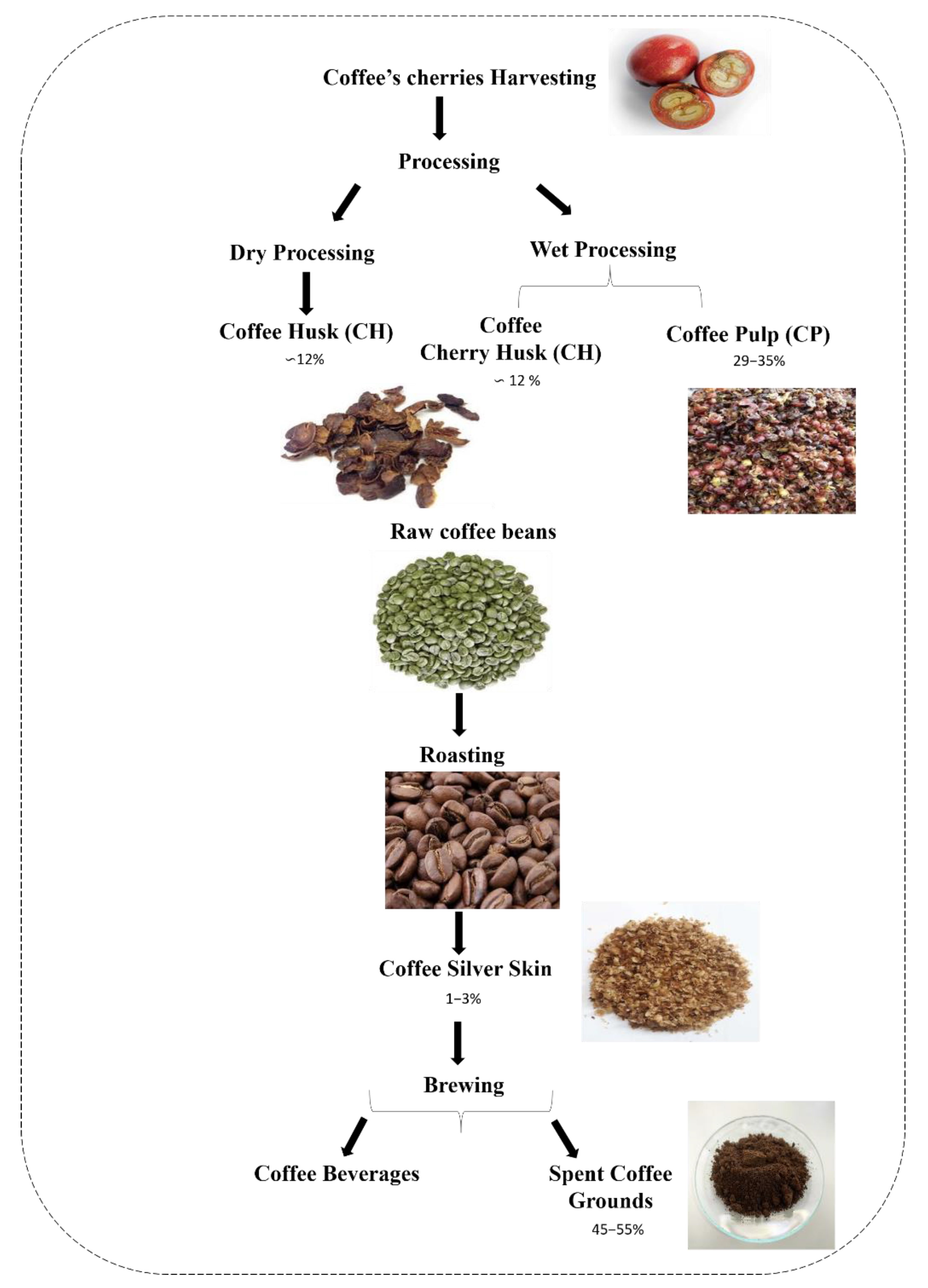
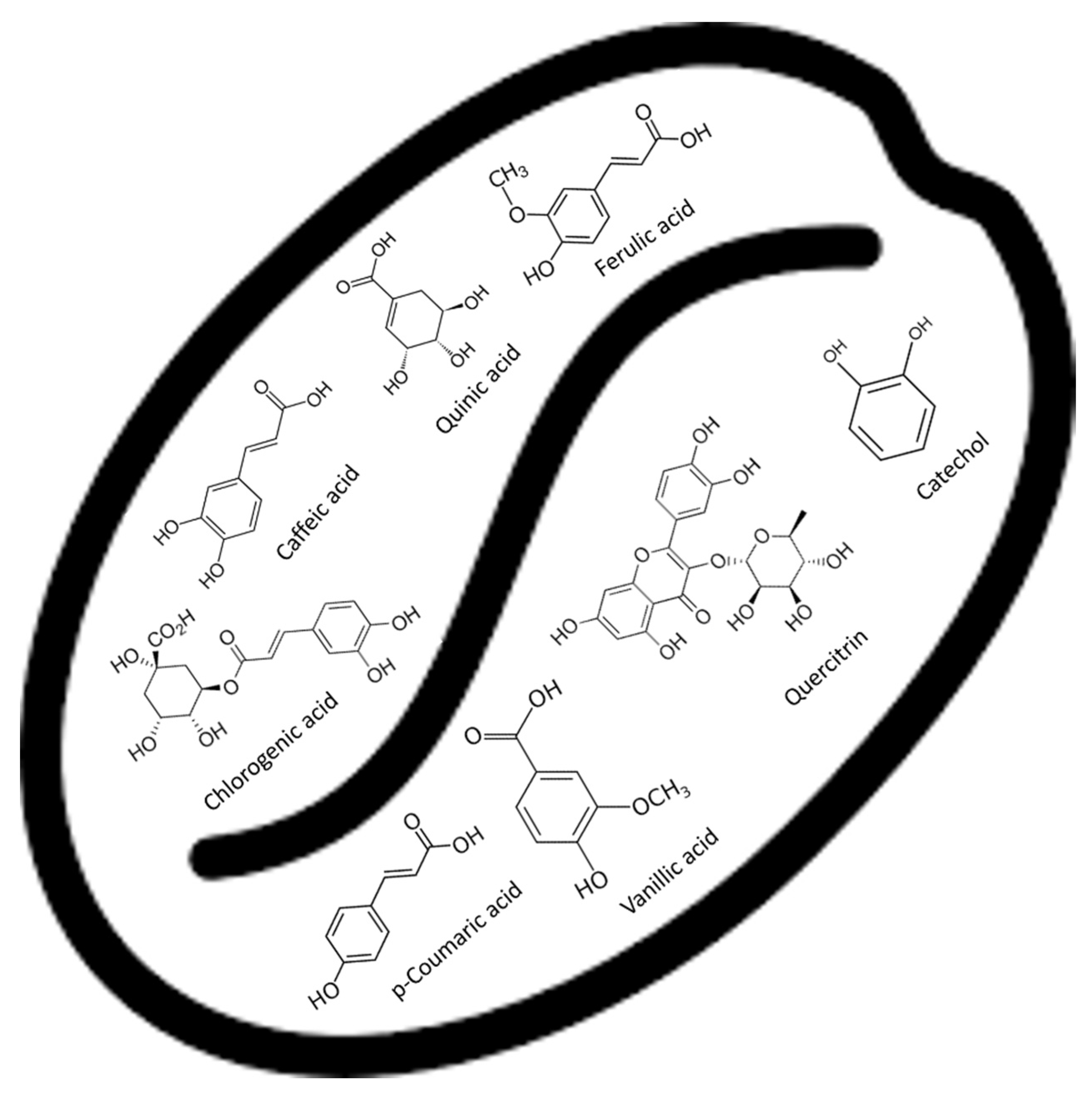
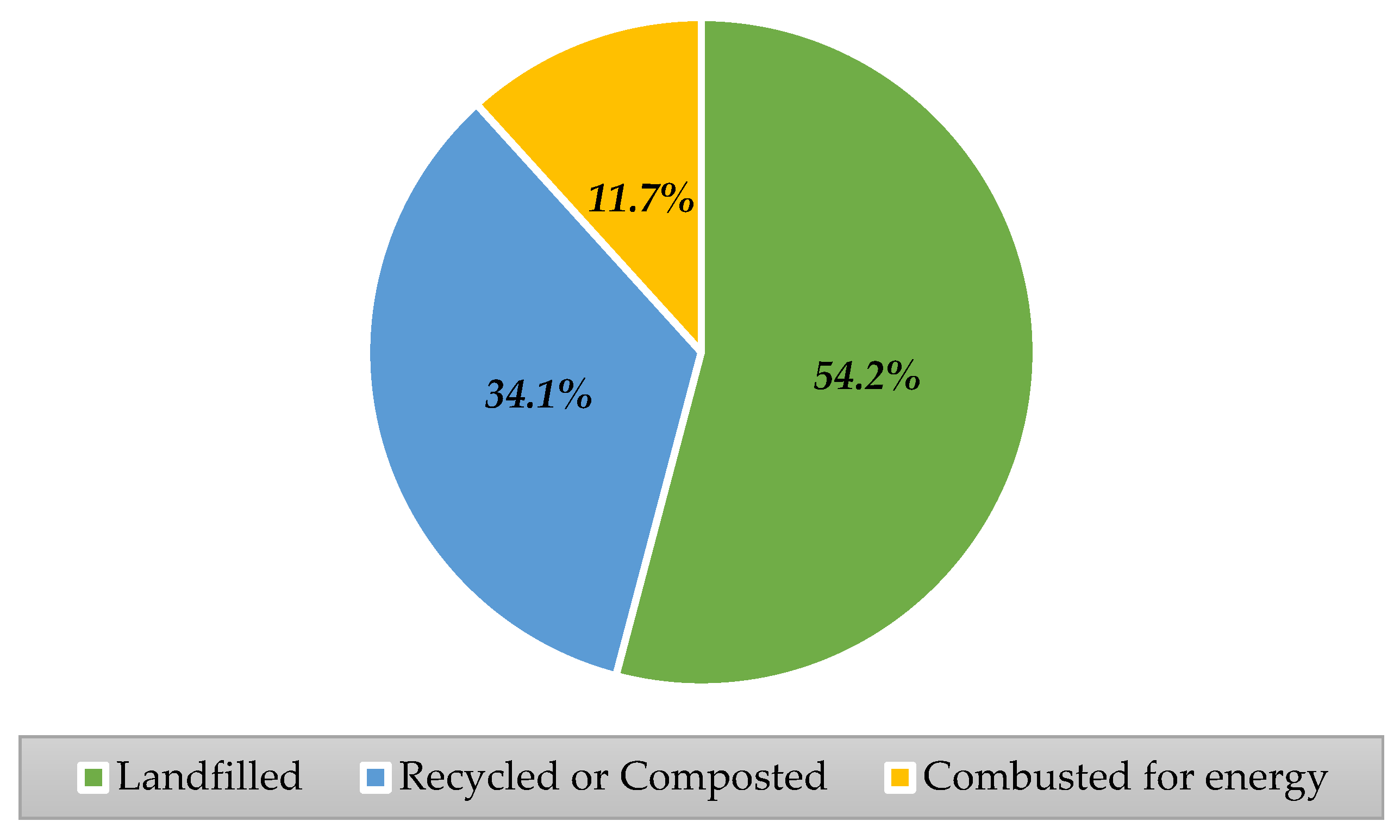
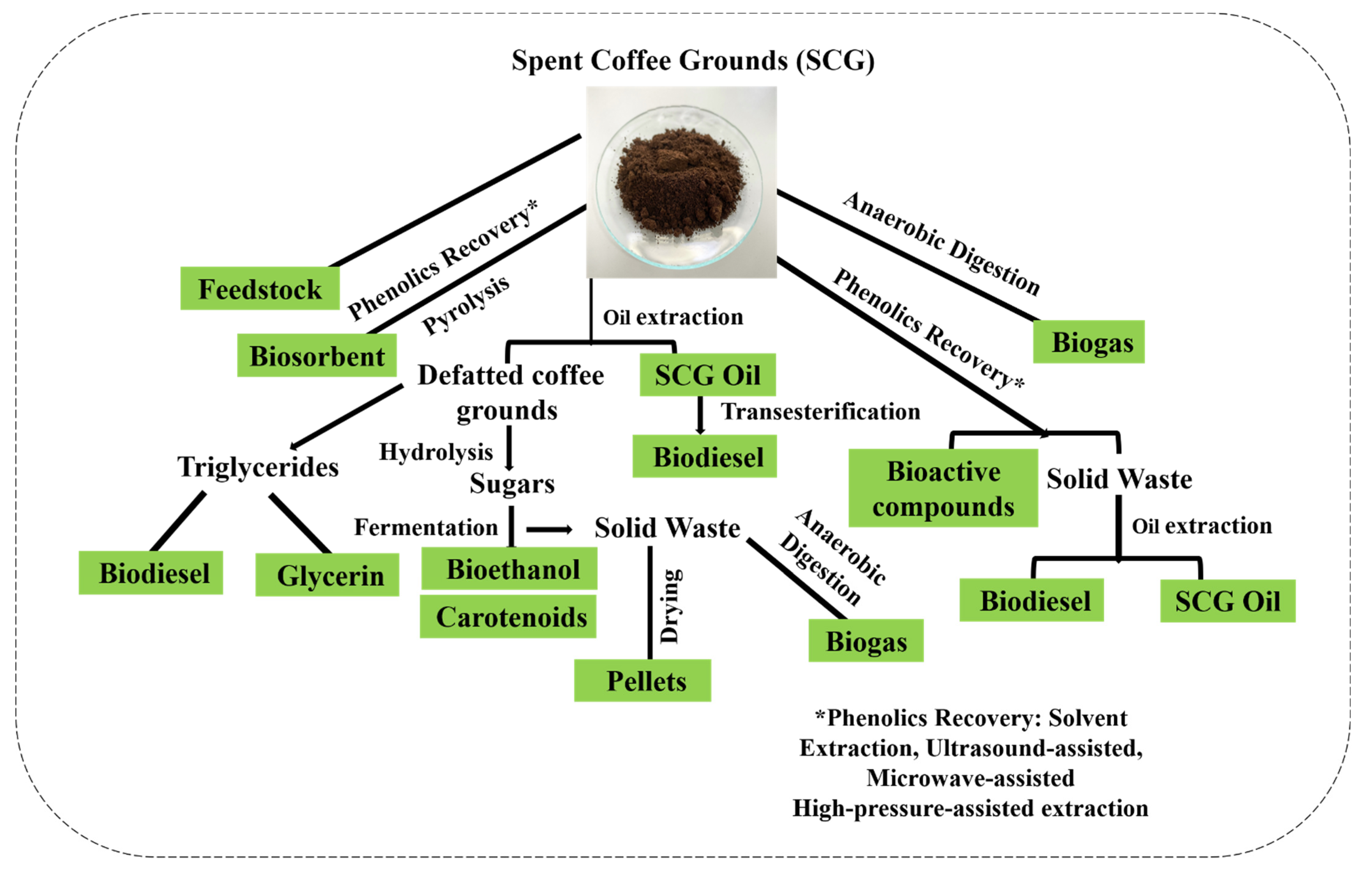
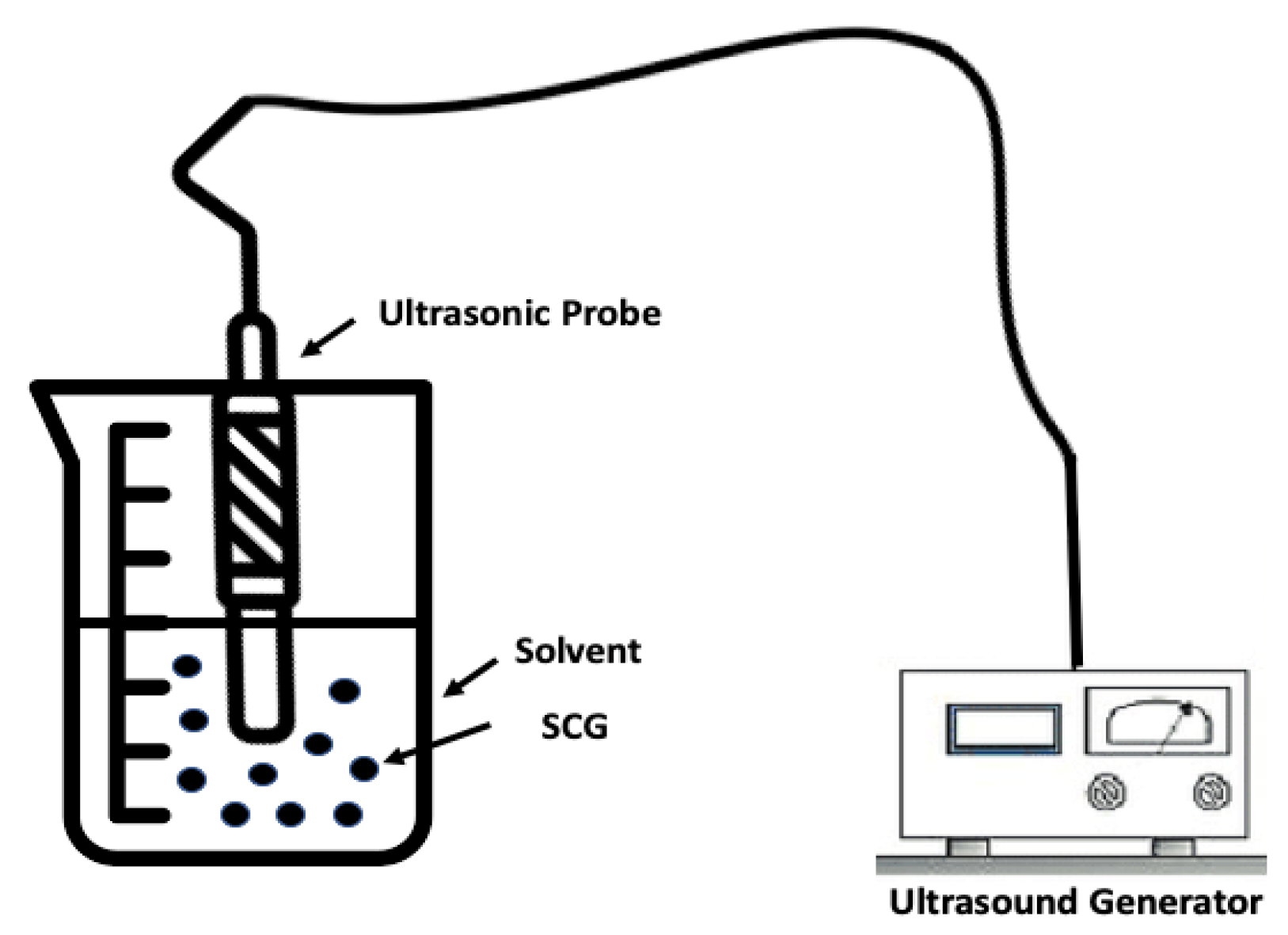
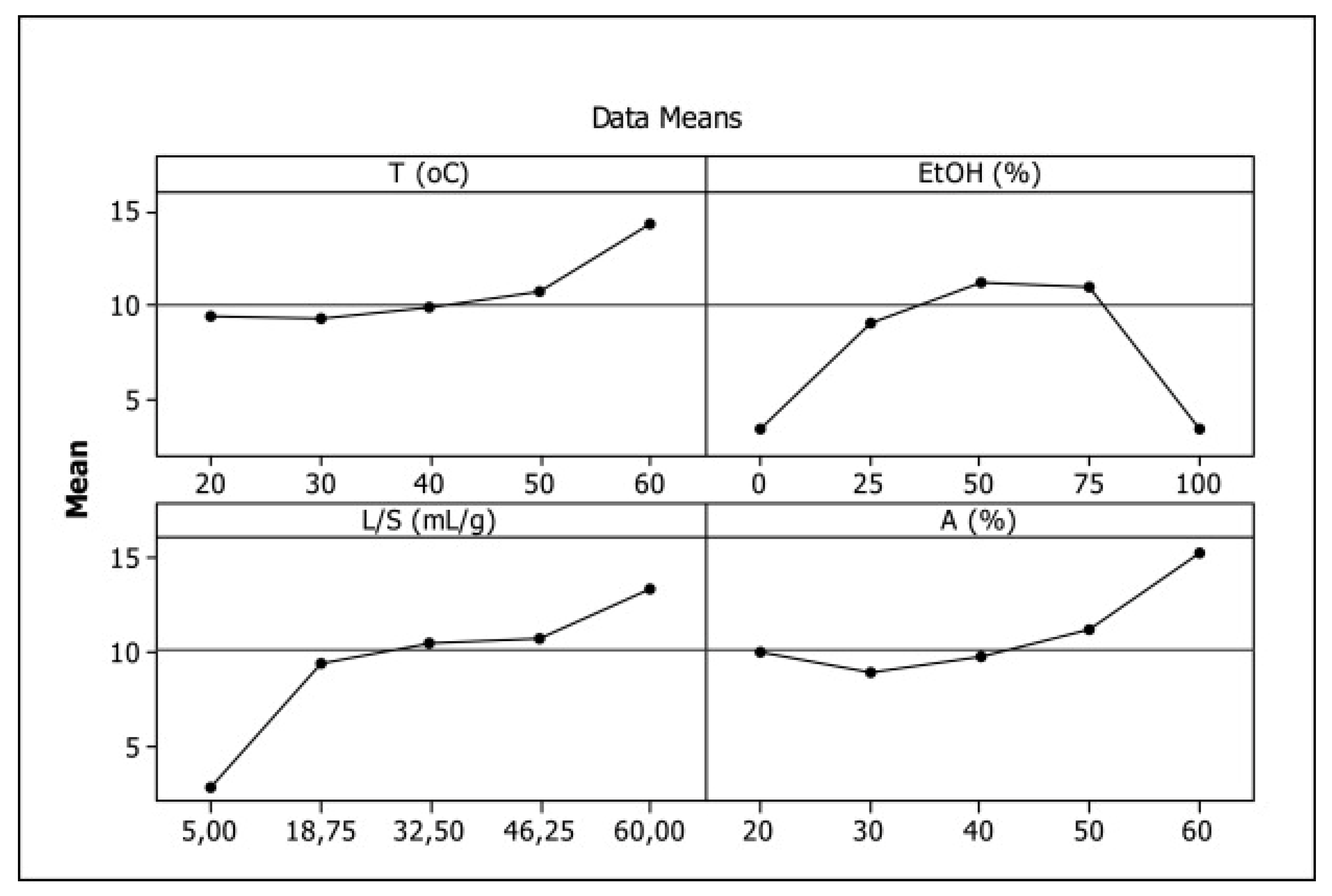
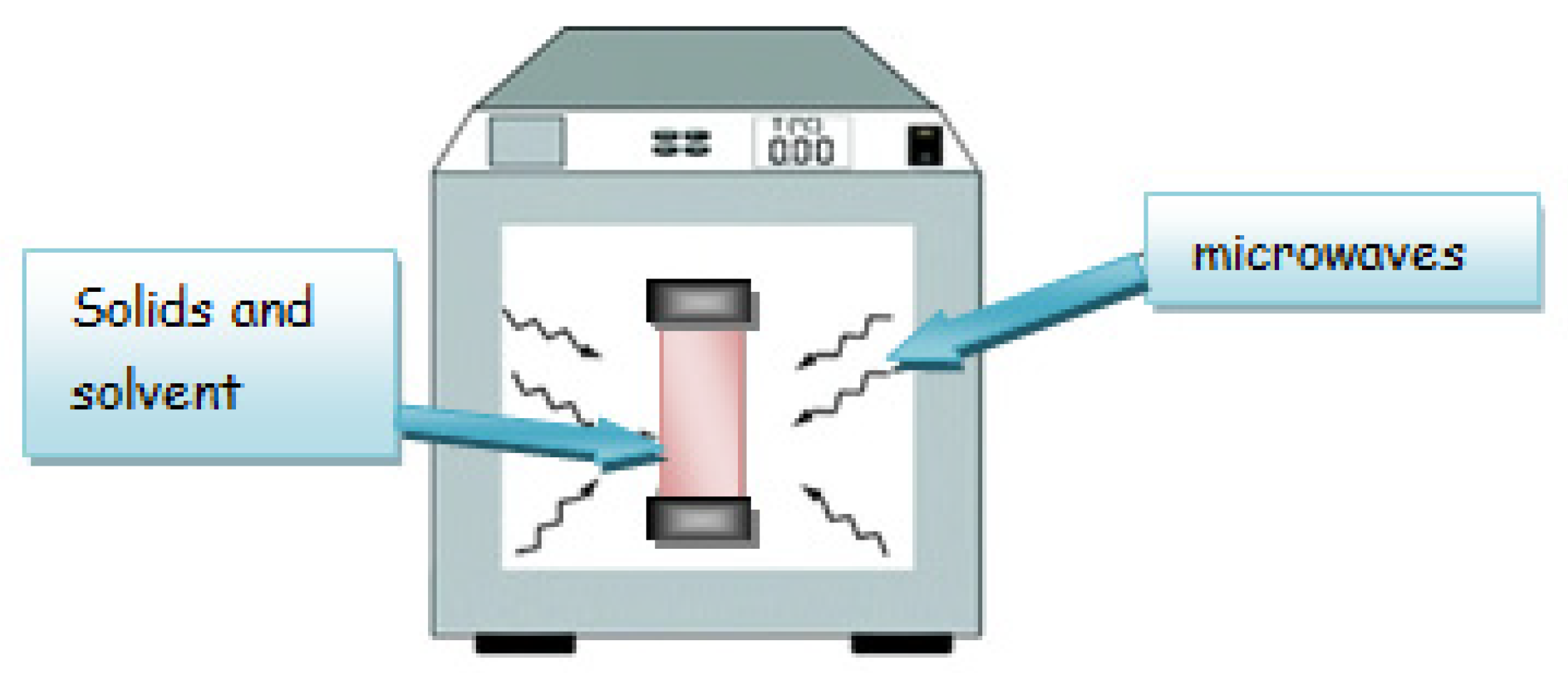
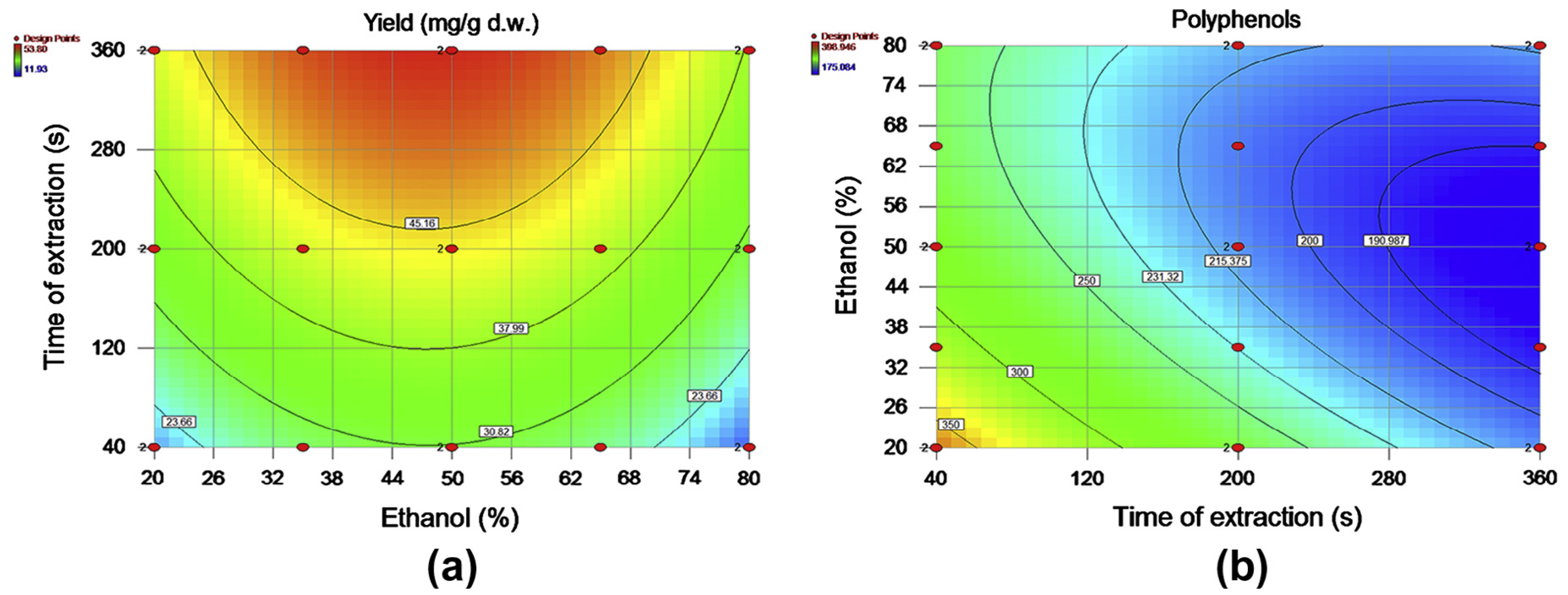
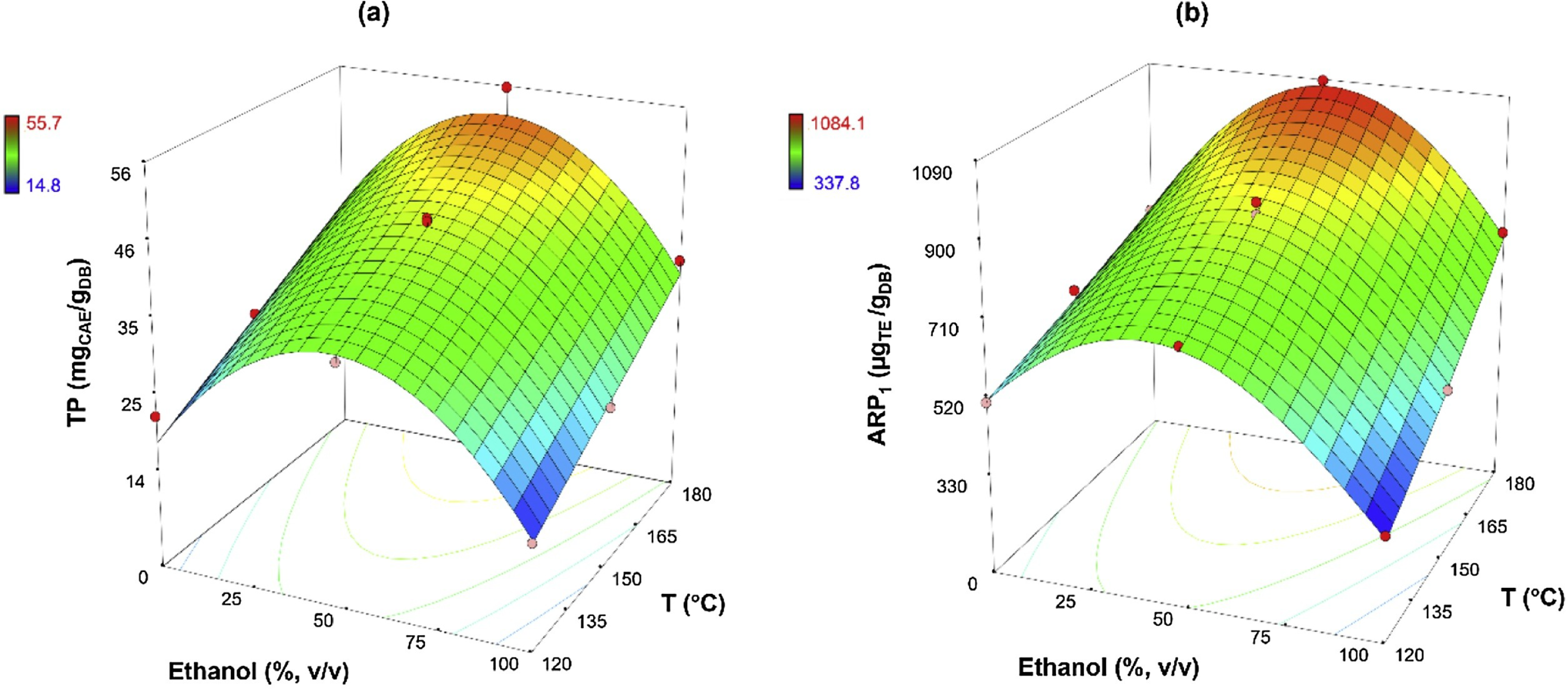
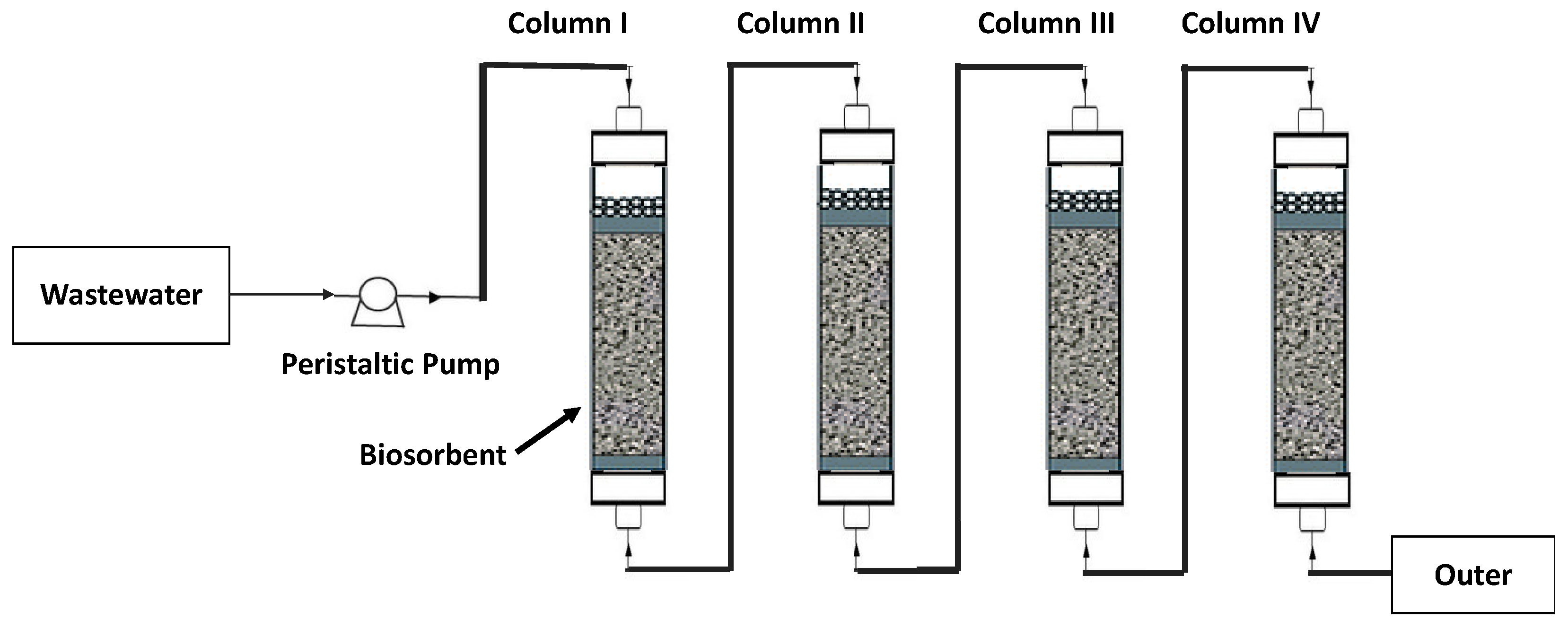
| Component | Content (% Wet Basis) | References |
|---|---|---|
| Moisture | 1.18–74.72 | [28,31,33] |
| Cellulose | 12.40 ± 0.79 | [34] |
| Hemicellulose | 39.10 ± 1.94 | [34] |
| Arabinose | 3.60–6.00 | [33,34] |
| Mannose | 19.07–47.00 | [33,34] |
| Galactose | 16.43–30.00 | [33,34] |
| Lignin | 23.90 ± 1.70 Insoluble 17.59 ± 1.56 Soluble 6.31 ± 0.37 | [34] |
| Fat | 2.29–19.00 | [28,33,34] |
| Ash | 0.43–2.20 | [31,33,34] |
| Protein | 4.30–17.44 | [9,31,33,34] |
| Total dietary fibers | 36.87–60.46 Insoluble 50.78 ± 1.58 Soluble 9.68 ± 2.70 | [34,31] |
| Constituent | Content (mg/g) |
| Caffeoylquinic Acids | |
| 3-*CQA | Arabica 1.10–1.64 Robusta 0.63–0.83 |
| 4-*CQA | Arabica 1.75–2.51 Robusta 0.97–1.16 |
| 5-*CQA | Arabica 2.48–3.59 Robusta 1.18–1.26 |
| Total *CQAs | Arabica 5.33–7.74 Robusta 2.80–2.91 |
| 3,4-**diCQA | Arabica 2.34–2.53 Robusta 1.49–1.99 |
| 3,5-**diCQA | Arabica 1.09–1.26 Robusta 0.62–0.74 |
| 4,5-**diCQA | Arabica 1.46–2.07 Robusta 1.20–1.41 |
| Total **diCQAs | Arabica 4.89–5.79 Robusta 3.31-4.10 |
| Total *CQAs + **diCQAs | Arabica 11.05–13.24 Robusta 6.22–7.49 |
| Caffeine | |
| Caffeine | Arabica 3.59–5.20 Robusta 5.73–8.09 |
| Operating Conditions | Solvent | Yield | Antioxidant Activity | References |
|---|---|---|---|---|
| T: 35 °C, L/S: 5 mL/g | Ethanol, 50% v/v | - | EC50: 148.4 ± 30.4 (non-defatted) EC50: 165.9 ± 6.8 mg/L (defatted) | [32] |
| T: 63.3 °C, t: 90 min, L/S: 30 mL/g | Ethanol, 45% v/v | 90% | 255.55 g SCG d.b./g DPPH | [60] |
| t: 90 min, L/S: 40 mL/g | Methanol, 60% v/v | 89% | 0.10 mM Fe(II)/g | [61] |
| T: 60 °C, t: 30 min, L/S: 50 mL/g | Ethanol, 60% v/v | - | EC50: 1.47–3.67% v/v | [62] |
| T: 60 °C, t: 30 min, L/S: 50 mL/g | Water | - | EC50: 2.33– 6.74% v/v | [62] |
| T: 80 °C, t: 30 min, L/S: 13.33 mL/g | Ethanol, 50% v/v | 14.5 ± 0.3 mg GAE/g (dw) | - | [63] |
| T: 60 °C, t: 150 min, L/S: 50 mL/g | Ethanol, 30% v/v | 87.3% | - | [46] |
| T: 60 °C, t: 90 min, L/S: 49 mL/g | Ethanol, 60% v/v | 22.01 mg/g d.b. | - | [64] |
| T: 60 °C, t: 180 min, L/S: 50 mL/g | Ethanol, 30% v/v | 90.35% | EC50: 0.86% v/v | [59] |
Publisher’s Note: MDPI stays neutral with regard to jurisdictional claims in published maps and institutional affiliations. |
© 2022 by the authors. Licensee MDPI, Basel, Switzerland. This article is an open access article distributed under the terms and conditions of the Creative Commons Attribution (CC BY) license (https://creativecommons.org/licenses/by/4.0/).
Share and Cite
Solomakou, N.; Tsafrakidou, P.; Goula, A.M. Valorization of SCG through Extraction of Phenolic Compounds and Synthesis of New Biosorbent. Sustainability 2022, 14, 9358. https://doi.org/10.3390/su14159358
Solomakou N, Tsafrakidou P, Goula AM. Valorization of SCG through Extraction of Phenolic Compounds and Synthesis of New Biosorbent. Sustainability. 2022; 14(15):9358. https://doi.org/10.3390/su14159358
Chicago/Turabian StyleSolomakou, Nikoletta, Panagiota Tsafrakidou, and Athanasia M. Goula. 2022. "Valorization of SCG through Extraction of Phenolic Compounds and Synthesis of New Biosorbent" Sustainability 14, no. 15: 9358. https://doi.org/10.3390/su14159358
APA StyleSolomakou, N., Tsafrakidou, P., & Goula, A. M. (2022). Valorization of SCG through Extraction of Phenolic Compounds and Synthesis of New Biosorbent. Sustainability, 14(15), 9358. https://doi.org/10.3390/su14159358






